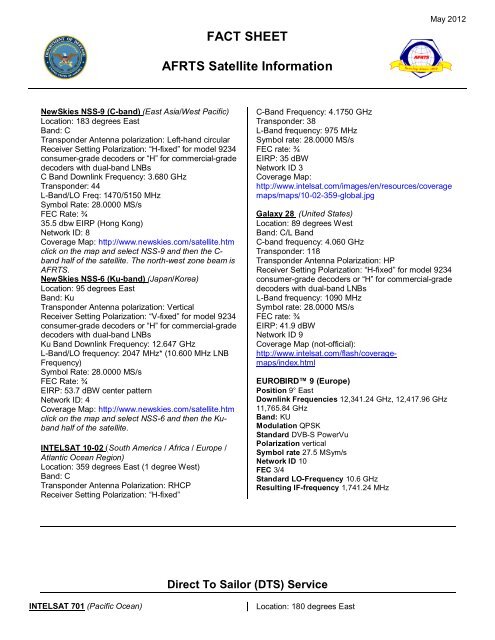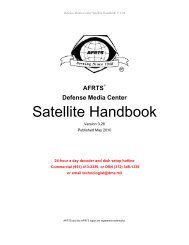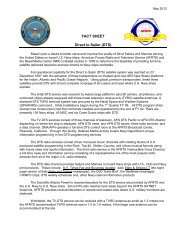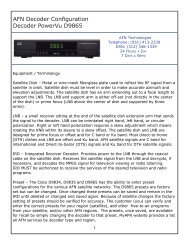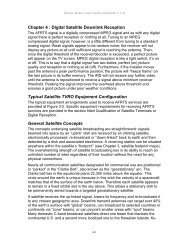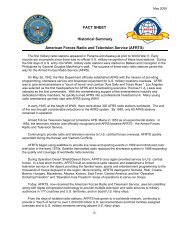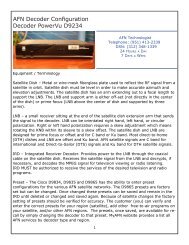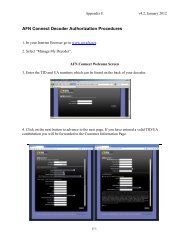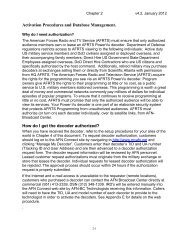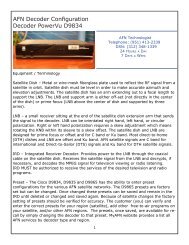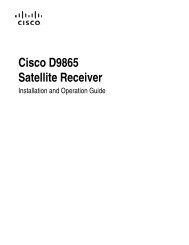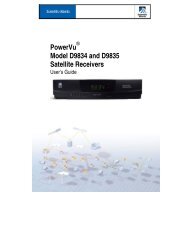FACT SHEET AFRTS Satellite Information
FACT SHEET AFRTS Satellite Information
FACT SHEET AFRTS Satellite Information
Create successful ePaper yourself
Turn your PDF publications into a flip-book with our unique Google optimized e-Paper software.
NewSkies NSS-9 (C-band) (East Asia/West Pacific)<br />
Location: 183 degrees East<br />
Band: C<br />
Transponder Antenna polarization: Left-hand circular<br />
Receiver Setting Polarization: “H-fixed” for model 9234<br />
consumer-grade decoders or “H” for commercial-grade<br />
decoders with dual-band LNBs<br />
C Band Downlink Frequency: 3.680 GHz<br />
Transponder: 44<br />
L-Band/LO Freq: 1470/5150 MHz<br />
Symbol Rate: 28.0000 MS/s<br />
FEC Rate: ¾<br />
35.5 dbw EIRP (Hong Kong)<br />
Network ID: 8<br />
Coverage Map: http://www.newskies.com/satellite.htm<br />
click on the map and select NSS-9 and then the Cband<br />
half of the satellite. The north-west zone beam is<br />
<strong>AFRTS</strong>.<br />
NewSkies NSS-6 (Ku-band) (Japan/Korea)<br />
Location: 95 degrees East<br />
Band: Ku<br />
Transponder Antenna polarization: Vertical<br />
Receiver Setting Polarization: “V-fixed” for model 9234<br />
consumer-grade decoders or “H” for commercial-grade<br />
decoders with dual-band LNBs<br />
Ku Band Downlink Frequency: 12.647 GHz<br />
L-Band/LO frequency: 2047 MHz* (10.600 MHz LNB<br />
Frequency)<br />
Symbol Rate: 28.0000 MS/s<br />
FEC Rate: ¾<br />
EIRP: 53.7 dBW center pattern<br />
Network ID: 4<br />
Coverage Map: http://www.newskies.com/satellite.htm<br />
click on the map and select NSS-6 and then the Kuband<br />
half of the satellite.<br />
INTELSAT 10-02 (South America / Africa / Europe /<br />
Atlantic Ocean Region)<br />
Location: 359 degrees East (1 degree West)<br />
Band: C<br />
Transponder Antenna Polarization: RHCP<br />
Receiver Setting Polarization: “H-fixed”<br />
<strong>FACT</strong> <strong>SHEET</strong><br />
<strong>AFRTS</strong> <strong>Satellite</strong> <strong>Information</strong><br />
Direct To Sailor (DTS) Service<br />
May 2012<br />
C-Band Frequency: 4.1750 GHz<br />
Transponder: 38<br />
L-Band frequency: 975 MHz<br />
Symbol rate: 28.0000 MS/s<br />
FEC rate: ¾<br />
EIRP: 35 dBW<br />
Network ID 3<br />
Coverage Map:<br />
http://www.intelsat.com/images/en/resources/coverage<br />
maps/maps/10-02-359-global.jpg<br />
Galaxy 28 (United States)<br />
Location: 89 degrees West<br />
Band: C/L Band<br />
C-band frequency: 4.060 GHz<br />
Transponder: 118<br />
Transponder Antenna Polarization: HP<br />
Receiver Setting Polarization: “H-fixed” for model 9234<br />
consumer-grade decoders or “H” for commercial-grade<br />
decoders with dual-band LNBs<br />
L-Band frequency: 1090 MHz<br />
Symbol rate: 28.0000 MS/s<br />
FEC rate: ¾<br />
EIRP: 41.9 dBW<br />
Network ID 9<br />
Coverage Map (not-official):<br />
http://www.intelsat.com/flash/coveragemaps/index.html<br />
EUROBIRD 9 (Europe)<br />
Position 9° East<br />
Downlink Frequencies 12,341.24 GHz, 12,417.96 GHz<br />
11,765.84 GHz<br />
Band: KU<br />
Modulation QPSK<br />
Standard DVB-S PowerVu<br />
Polarization vertical<br />
Symbol rate 27.5 MSym/s<br />
Network ID 10<br />
FEC 3/4<br />
Standard LO-Frequency 10.6 GHz<br />
Resulting IF-frequency 1,741.24 MHz<br />
INTELSAT 701 (Pacific Ocean) Location: 180 degrees East
Band: C<br />
Transponder Antenna Polarization: LHCP<br />
Receiver Setting Polarization: “H-fixed”<br />
C-Band frequency: 4.1735 GHz<br />
L-Band frequency: 976.5 MHz<br />
Symbol Rate: 3.6800 MS/s<br />
FEC rate: 2/3<br />
EIRP: 29.0 dBW<br />
Network ID 5<br />
Coverage map:<br />
http://www.intelsat.com/images/en/resources/coveragema<br />
ps/maps/701-180-global.jpg (global)<br />
INTELSAT 906 (Indian Ocean and Persian Gulf)<br />
Location: 64.1 degrees East<br />
Band: C<br />
Transponder Antenna Polarization: LHCP<br />
Receiver Setting Polarization: “H-fixed”<br />
C-Band frequency: 4093.5 MHz<br />
L-Band frequency: 1056.5 MHz<br />
Symbol Rate: 3.6800 MS/s<br />
FEC Rate: 2/3<br />
EIRP: 29.0 dBW<br />
Network ID 7<br />
Coverage map:<br />
http://www.intelsat.com/images/en/resources/coveragema<br />
ps/maps/906-64-global.jpg (global)<br />
*Important note on LNB frequencies:<br />
All C-band LNB’s have a local oscillator (L.O.)<br />
frequency of 5.150 GHz but Ku-band LNB’s may come<br />
in many different frequencies typically 9.750 to 12.75<br />
GHz. This means that if you’re attempting to watch a<br />
Ku-band service you need to set the decoder’s<br />
frequency using a bit of simple math. The formula to<br />
set the Ku-Low/Single L.O. frequency on the <strong>AFRTS</strong><br />
decoder is the downlink frequency minus the L.O.<br />
frequency. As an example the downlink frequency for<br />
the INTELSAT 804 satellite serving the Japan and<br />
Korea Direct to Home service area is 11.6380<br />
GHz. An LNB with a local oscillator frequency of<br />
10.000 GHz would give a Ku Low/Single L.O.<br />
frequency of 1638 MHz (1.638 GHz) by working the<br />
math problem 11.16380 – 10.000 = 1.638. The Kuband<br />
satellite serving the European service area is<br />
Eurobird at 9 degrees east.<br />
Nov 2011<br />
New Skies NSS-7<br />
(Atlantic Ocean and Mediterranean Sea)<br />
Location: 338.0 degrees East (22 degrees West)<br />
Band: C<br />
Transponder Antenna Polarization: LHCP<br />
Receiver Setting Polarization: “H-fixed”<br />
C-Band frequency: 4115 MHz<br />
L-Band frequency: 1035 MHz<br />
Symbol Rate: 3.6800 MS/s<br />
FEC Rate: 2/3<br />
EIRP: 30.5 dBW<br />
Network ID 6<br />
Coverage map: http://www.newskies.com/satellite.htm<br />
(global)


